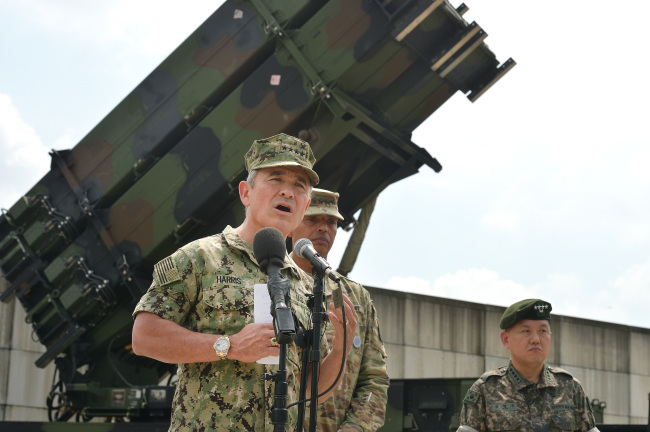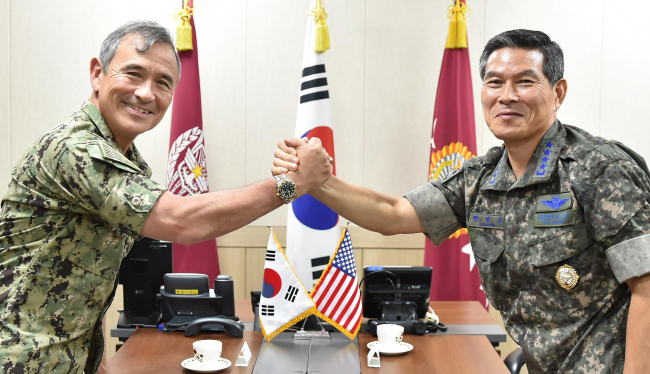Diplomacy is ‘stronger, more powerful’ in standoff with NK: US Pacific commander
 |
| Adm. Harry Harris talks during a press conference at Osan Air Base in South Korea. (Yonhap) |
The top US military commander in the Asia-Pacific region said Tuesday that the diplomatic approach is the “stronger and more powerful” means to resolve the standoff with North Korea, adding such efforts should be backed by credible military capability.
“Diplomatic maneuver has to be applied first and diplomacy is stronger, effective and more powerful if it is backed by credible military power,” said Adm. Harry Harris, commander of the US Pacific Command, during a press conference at Osan Air Base in South Korea.
“The most important starting point is that diplomatic starting point. We hope and work for a diplomatic solution to the challenge presented by (North Korean leader) Kim Jong-un, because credible combat power should be in support of diplomacy and not the other way around.”
Harris was in Seoul to observe the allies’ military drill, Ulchi Freedom Guardian, alongside other top US generals, such as Air Force Gen. John Hyten, commander of the US Strategic Command, Gen. Samuel A. Greaves, director of the US Missile Defense Agency, and US Forces Korea Commander Gen. Vincent Brooks.
 |
Their unusual joint press conference in South Korea was seen as an effort to reassure US commitment to defending South Korea amid concerns in Seoul over a possible unilateral military action by tough-talking US President Donald Trump.
It also came amid high tensions on the Korean Peninsula, with North Korea issuing a batch of fresh warnings over the UFG exercise, a command-post drill where 50,000 South Korean and 17,500 US troops participated to simulate a war with North Korea.
In a statement released by North Korea‘s military stationed at the truce village of Panmunjom on Tuesday, Pyongyang described the drill as “reckless and aggressive” war maneuvers and threatened to stage a “ruthless retaliation” unless the US heeds their warning.
On Saturday, the North Korean propaganda website Uriminzokkiri uploaded a short video containing a computerized image of North Korean missiles flying toward Guam, a plan delayed by Kim Jong-un who said he would “watch a little more” the conduct of the US before approving it.
The nearly four-minute long clip, uploaded on YouTube, showed a photo of Pyongyang’s announcement of attack plan on Guam with the subtitle, “the fake image of the US as a super power laid bare to the whole world.”
Gen. Brooks said while North Korea poses “danger and deadly” threat to the allies, Pyongyang’s decision to delay the missile launch toward Guam shows “success” for the diplomatic efforts and strong military foundation is key to prevent Pyongyang from staging provocations.
“Having a pause in provocations is always a good thing. That means there would be some success for diplomatic efforts. Key decision should be left up to Kim Jung-un. In the meantime, we are going to exercise because we need to be ready,” Brooks told the reporters.
Brooks dismissed North Korea’s call for suspension of UFG exercise, saying the allies would continue the annual drill until they have “a reason not to do so.” The drill began on Monday and is expected to last until the end of this month.
 |
| Gen. Harris(left) and South Korea`s Chairman of Joints Chief of Staff Air Gen. Jeong Kyeong-doo. Yonhap |
Gen. Hyten, who is in charge of managing US strategic assets such as nuclear-powered submarines and long-range bombers, reaffirmed US security commitment toward South Korea, saying his command is ready to prove “all capabilities” to fend off North Korea’s attack.
“With our Korean ally, I am a supporting commander to Gen. Brooks, the CFC commander, I will provide all capability such as missile defense capability,” said Hyten during the press conference at the background of US Patriot launchers stationed in Osan for air-defense mission.
Following the press conference, the US top generals paid a visit to a US military site in Seongju, North Gyeongsang, two launchers of the American anti-missile shield Terminal High Altitude missile system is stationed.
Earlier in the day, Gen. Harris met with South Korea’s Foreign Minister Kang Kyung-hwa and Chairman of Joints Chief of Staff Air Gen. Jeong Kyeong-doo, reiterating the allies’ firm commitment to fending off North Korea’s military threat.
During the meeting with Kang, Harris highlighted the importance of a diplomatic approach to resolve the North Korean nuclear crisis, describing diplomacy as the “main battery” and the military capability as “support wing.”
Kang echoed the remark, saying that both military and diplomatic measures should go hand in hand, according to the South Korean Foreign Ministry.
Kang also underlined the importance of the “prompt” transfer of the US wartime operational control of Korean troops, as well as the need to revise bilateral missile guidelines that restrict the range and destructive power of missiles made in South Korea, the ministry added.
By Yeo Jun-suk (jasonyeo@heraldcorp.com)
Source:.koreaherald.com